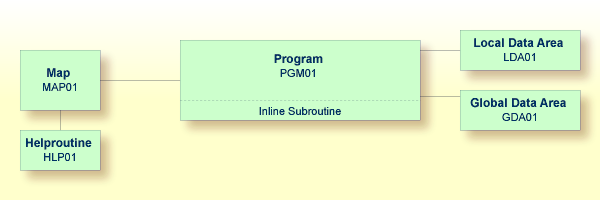Data defined in a global data area (GDA) can be shared by multiple programs, external subroutines and helproutines.
Any modification of a data element value in a global data area affects all Natural objects that reference this global data area. Therefore, if you change the source of a global data area, you have to stow all previously created Natural objects that reference this global data area once more. The sequence in which objects are stowed is important. You must first stow the global data area and then the program. If you stow the program first and then the global data area, the program cannot be stowed because new elements in the global data area cannot be found.
You will now create a global data area which will be shared by your program and an external subroutine that you will create later. As the basis for your global data area, you will use some of the information from the local data area you have just created.
When you have completed the exercises below, your sample application will consist of the following modules:

This document contains the following exercises:
You can create a new data area from an existing data area by editing it
and saving it under a different name and with a different type. The original
data area remains unchanged, and the new data area can be edited. Since the
fields #NAME-START and #NAME-END are not required in
the global data area, you will remove them.
![]() To create the global data area
To create the global data area
Return to your local data area by entering the following in the command line of the program editor.
E LDA01
To save the data area under a new name, enter the following in the command line of the data area editor.
SA GDA01
The current data area is saved with the new name
GDA01. The local data area named LDA01 is still shown
in the data area editor.
Load GDA01 into the data area editor by
entering the following command:
E GDA01
To change the local data area into a global data area, enter the following command:
SET TYPE G
where "G" denotes global data area.
The object type changes to "Global". This is indicated at the top of the screen.
Press ESC to enter edit
mode. Use the line command D to delete the
following fields:
#NAME-START
#NAME-END
The global data area should now look as follows:
Press <ESC> to enter command mode
Mem: GDA01 Lib: TUTORIAL Type: GLOBAL Bytes: 351 Line: 1 of: 8
C T L Name of Datafield F Length Index/Comment M
* *** Top of Data Area ***
1 #MARK A 1
V 1 EMPLOYEES-VIEW EMPLOYEES
2 PERSONNEL-ID A 8
G 2 FULL-NAME
3 NAME A 20
2 DEPT A 6
G 2 LEAVE-DATA
3 LEAVE-DUE N 2
* *** End of Data Area ***
F 1 HELP F 2 CHOICE F 3 QUIT F 4 SAVE F 5 STOW F 6 CHECK
F 7 READ F 8 CLEAR F 9 MEM TYPE F10 GEN F11 FLD TYPE F12 |
Stow the global data area.
The fields contained in the global data area are no longer required in
the local data area. Therefore, you will now remove all fields except
#NAME-START and #NAME-END from the local data
area.
![]() To remove the fields
To remove the fields
Return to your local data area by entering the following in the command line of the data area editor:
E LDA01
Use the line command D to
delete all fields except #NAME-START and
#NAME-END.
When you delete the top-level entry for the view (indicated by a "V" in front of the view name), all fields belonging to this view are automatically deleted.
Stow the modified local data area.
The local data area should now look as follows:
Command:
Mem: LDA01 Lib: TUTORIAL Type: LOCAL Bytes: 85 Line: of: 2
C T Comment
* *** Top of Data Area ***
1 #NAME-START A 20
1 #NAME-END A 20
* *** End of Data Area ***
F 1 HELP F 2 CHOICE F 3 QUIT F 4 SAVE F 5 STOW F 6 CHECK
F 7 READ F 8 CLEAR F 9 MEM TYPE F10 GEN F11 FLD TYPE F12 |
Once a global data area has been stowed, it can be referenced by a Natural program.
You will now change the DEFINE DATA statement in your
program so that it also uses the global data area that you have just
defined.
![]() To use the global data area in your program
To use the global data area in your program
Return to the program editor by entering the following in the command line of the data area editor.
E PGM01
Insert the following in the line above LOCAL USING
LDA01:
GLOBAL USING GDA01
A global data area must always be defined before a local data area. Otherwise, an error occurs.
Your program should now look as follows:
DEFINE DATA
GLOBAL USING GDA01
LOCAL USING LDA01
END-DEFINE
*
RP1. REPEAT
*
INPUT USING MAP 'MAP01'
*
IF #NAME-START = '.' THEN
ESCAPE BOTTOM (RP1.)
END-IF
*
IF #NAME-END = ' ' THEN
MOVE #NAME-START TO #NAME-END
END-IF
*
RD1. READ EMPLOYEES-VIEW BY NAME
STARTING FROM #NAME-START
ENDING AT #NAME-END
*
IF LEAVE-DUE >= 20 THEN
PERFORM MARK-SPECIAL-EMPLOYEES
ELSE
RESET #MARK
END-IF
*
DISPLAY NAME 3X DEPT 3X LEAVE-DUE 3X '>=20' #MARK
*
END-READ
*
IF *COUNTER (RD1.) = 0 THEN
REINPUT 'No employees meet your criteria.'
END-IF
*
END-REPEAT
*
DEFINE SUBROUTINE MARK-SPECIAL-EMPLOYEES
MOVE '*' TO #MARK
END-SUBROUTINE
*
END
Run the program.
To confirm that the results are the same as before (when the
DEFINE DATA statement did not reference a global data area), enter
"JONES" as the starting name and press
ENTER.
To return to the program editor, enter
EDIT at the MORE prompt.
Stow the program.
You can now proceed with the next exercises: External Subroutines.